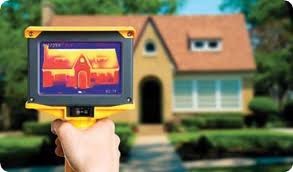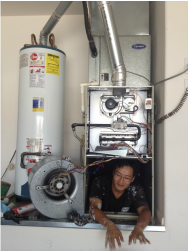For the first 2 years of my home performance business, I did resisted the itch to purchase a thermal camera. I think anyone starting their energy audit business wonders the same thing. Furthermore, I debated what type of thermal camera to buy. There was the $10,000 thermal cameras, the $2,500 low end IR guns and then there were the manufacturers, FLIR or FLUKE. I wondered if I should I get certified to use them. It can be hard to wade through all the choices for a potentially large investment. While my home performance business survived fine without the infrared camera and now I have two low end FLIR cameras. I sometimes sub out my overflow audits to another auditor who has a $10,000 FLIR camera and I can definitely see the difference between my cheap-o's and his high end camera.
Looking back, my low end infrared cameras were the right choice for a boot-strapping solo-prenuer as I was, but more importantly for my business and anyone asking themselves the same questions was the preparation implemented before the cameras were ever purchased. Specifically, it is imperative that processes and SOPs (stand operating procedures) are implemented for the IR cameras use. An IR camera is a big investment and even if its just you using them, setting guidelines now help to increase conversions and ensure smooth transitions when your energy auditing business grows.
Guidelines should be set for:
Once you have your SOPs and guidelines in order, it's time to pick a camera that's right for you. If you don't have much capital to work with, I vouch for the cheap $1,500 cameras to use as a selling tool. However I will add that I live in Phoenix where most of the homes have accessible attics and platform framing. If you live in an area where most of the homes have cathedralized attics, no accessible attics or were balloon framing was common, a thermal camera can be a very valuable diagnostic tool along with a good knowledge of pressure mapping. If you live in more temperate climate, a good IR camera will be able to discern insulation misalignments and air leakage better than a cheap camera. For example in the winter time in Phoenix, our IR cameras are basically paper weights.
Looking back, my low end infrared cameras were the right choice for a boot-strapping solo-prenuer as I was, but more importantly for my business and anyone asking themselves the same questions was the preparation implemented before the cameras were ever purchased. Specifically, it is imperative that processes and SOPs (stand operating procedures) are implemented for the IR cameras use. An IR camera is a big investment and even if its just you using them, setting guidelines now help to increase conversions and ensure smooth transitions when your energy auditing business grows.
Guidelines should be set for:
- Charging the camera the night before.
- It's use and how to work it (it's amazing how many newbies that are handed a camera leave the lens closed).
- Use during energy audits as a selling tool. Do you let the homeowner use it, what do you take the time to show the homeowner, how do you explain winter vs summer use, do yo use it before or after you do your blower door or attic inspection.
- Use during energy audits as a diagnostic tool. i.e. telling the difference between looking at air leaks verses insulation misalignments, how much time will it add to your audits.
- Its safe return and sign off sheets.
- Picture guidelines, how to tell what you are looking at if you don't have picture-in-picture. Also how do you differentiate between houses.
Once you have your SOPs and guidelines in order, it's time to pick a camera that's right for you. If you don't have much capital to work with, I vouch for the cheap $1,500 cameras to use as a selling tool. However I will add that I live in Phoenix where most of the homes have accessible attics and platform framing. If you live in an area where most of the homes have cathedralized attics, no accessible attics or were balloon framing was common, a thermal camera can be a very valuable diagnostic tool along with a good knowledge of pressure mapping. If you live in more temperate climate, a good IR camera will be able to discern insulation misalignments and air leakage better than a cheap camera. For example in the winter time in Phoenix, our IR cameras are basically paper weights.
Does Having a Thermal Camera Increase Sales?
It is difficult to say that having the infrared camera has directly contributed to more sales but I can contribute increased audits and therefore sales to having the IR camera.
However, if you do the thermal camera and never show the homeowner the pictures or the hot items you find live, having a thermal camera doesn't do any good. The more you show the homeowner and promote and sell using the thermal camera, the more value it adds and that increases sales.
- Many audits have been booked specifically because we offer a free infrared scan of the house and those audits have turned into sales.
- Using the infrared camera adds to wow factor when doing the audit but good pictures in the attic showing misalignments are also just as effective.
- Using a good thermal camera shows temperature differences much more vividly for homeowners.
- Some homeowners like it when get get to use the thermal cameras themselves. It adds value to the energy audits.
However, if you do the thermal camera and never show the homeowner the pictures or the hot items you find live, having a thermal camera doesn't do any good. The more you show the homeowner and promote and sell using the thermal camera, the more value it adds and that increases sales.
Where To Buy A Thermal Camera
Buying a FLIR and FLUKE thermal camera has to be done from approved distributors. Distributors typically add a nice mark up to their costs but offer technical support. Technical training may be best had by reading blogs and asking your peers. I do not have any experience with the infrared certifications offered. The cheapest way to buy a thermal camera and my preferred method is on eBay. There are i7 IR cameras regularly on sale for a flat rate of $1500.






 RSS Feed
RSS Feed